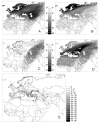Anatidae migration in the western Palearctic and spread of highly pathogenic avian influenza H5NI virus
- PMID: 17283613
- PMCID: PMC3372333
- DOI: 10.3201/eid1211.060223
Anatidae migration in the western Palearctic and spread of highly pathogenic avian influenza H5NI virus
Abstract
During the second half of 2005, highly pathogenic avian influenza (HPAI) H5N1 virus spread rapidly from central Asia to eastern Europe. The relative roles of wild migratory birds and the poultry trade are still unclear, given that little is yet known about the range of virus hosts, precise movements of migratory birds, or routes of illegal poultry trade. We document and discuss the spread of the HPAI H5N1 virus in relation to species-specific flyways of Anatidae species (ducks, geese, and swans) and climate. We conclude that the spread of HPAI H5N1 virus from Russia and Kazakhstan to the Black Sea basin is consistent in space and time with the hypothesis that birds in the Anatidae family have seeded the virus along their autumn migration routes.
Figures



References
Publication types
MeSH terms
LinkOut - more resources
Full Text Sources
Medical
